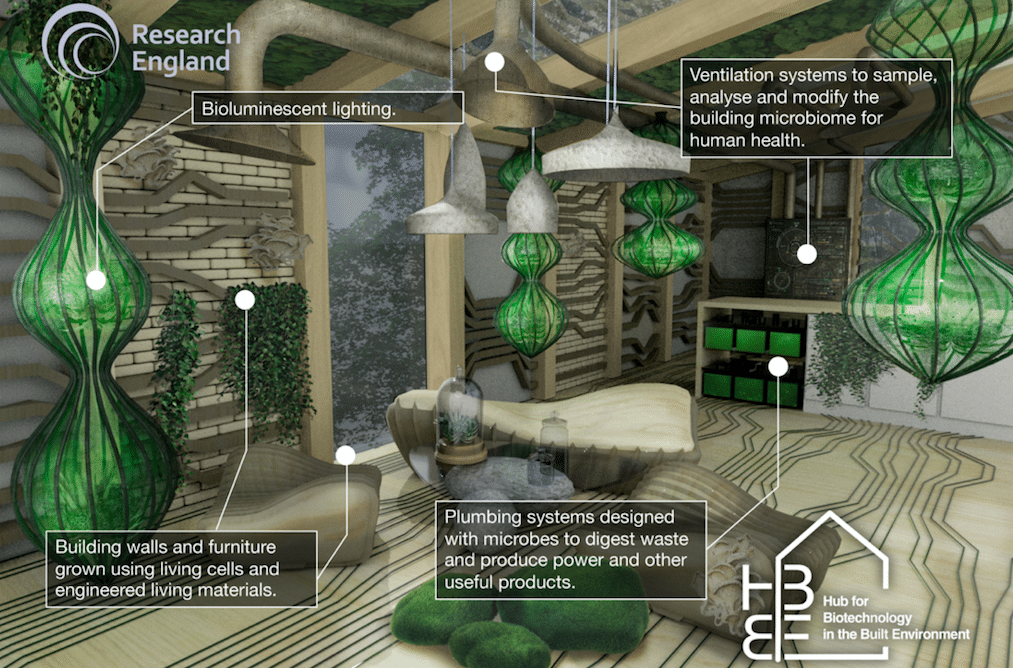
An organic house where your phone is recharged thanks to ‘production’ in the toilet, a smart ventilation system or bioluminescent lamps that emit light by themselves. This house will be built in England next year. It is the highlight of what is said to be the world’s first research hub that aims to create ‘living buildings’ by Newcastle and Northumbria universities. Delft researcher Henk Jonkers is a member of the steering committee.
Co-founder Dr. Martyn Dade-Robertson states that the house is an example of a genuine living building, one that grows, breathes and reproduces. Instead of just relying on materials and energy and producing waste that will have to be removed and treated on an industrial scale.
Dade from Newcastle University’s School of Architecture, Planning & Landscape refers to the development of a new type of micriobial fuel cell in this context. This absorbs household waste and generates small amounts of electricity. These cells are integrated into bricks that absorb waste water and bacteria then convert chemical energy into electrical energy once the waste has been decomposed. “In this hypothetical scenario, the toilet could charge your phone.”
Another proposal is a smart ventilation system that monitors air quality and keeps the home safe for human health on a micro-organic level. Or bioluminescent lighting that shines on its own accord. In general, genetically modified microbes are expected to play a major role by processing waste in the home and harnessing that as a source for generating energy.
Two labs too
As well as the organic house, the hub is also made up of two laboratories, spread over the two participating universities. The researchers’ new technologies are tested in these laboratories. The first stage started by recruiting the staff with 22 researchers. Dade explains that the experimental house will actually be built next spring.
The British universities in Newcastle and Northumbria hope that the eight million pounds (about nine million euros) subsidy for the first trial period of three years will be the first step towards a revolution in the construction industry. Houses will have to be designed and built with far more sustainable perspectives.
In itself, all the ideas that are to being applied are not new, but the practical application in this organic house is innovative. Although of course there is hope that there will be some remarkable discoveries made.
Aside from that, the hub distinguishes itself with its integrated approach. Dade: “It is an exciting opportunity for developing a field of research. By bringing together architects, engineers and environmental scientists and collaborating with industry and by investing in state-of-the-art facilities, we are trying to achieve a transformation in the way we think about construction”.
‘Healing’
Dade has high expectations regarding biotechnology in the new building. “The next step in building technology may be to make buildings part of nature. One of the ways in which I and colleagues think that buildings are capable of becoming living, breathing entities is the way in which they are able to ‘heal’. ”
Here, he’s referring to the potential for a bacteriological treatment of degraded concrete. A method that was first developed under the guidance of Henk Jonkers (TU Delft). Scientists are looking at the way in which bacterial spores can play a role in dealing with water that seeps into cracks in concrete which can corrode the metal structure of a building.
If this bacteria is present, water damage will activate the building’s healing process. This creates a chemical process that allows calcite crystals to grow which closes up any cracks. Dade says that this technique has the potential to add decades to the life of a building.
There are more interesting developments in the field of Living Buildings right now in the Netherlands. For example, it was recently announced that Utrecht University is receiving a subsidy for research into fungal architecture. Research is being carried out as part of the international Fungar Project in order to examine how fungus-based bricks may be used to build without using cement. These bricks are more sustainable and in the future would be able to repair themselves or adapt to their surroundings.

